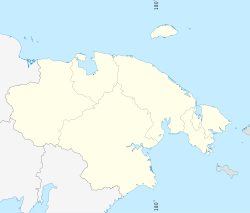Beringovsky (inhabited locality)
| Beringovsky (English) Беринговский (Russian) Гачгатагын (Chukchi) |
|
|---|---|
| - Urban-type settlement - | |
 Aerial winter view of Beringovsky |
|
 Location of Chukotka Autonomous Okrug in Russia |
|
|
|
|
|
|
|
| Administrative status (as of June 2012) | |
| Country | Russia |
| Federal subject | Chukotka Autonomous Okrug |
| Administrative district | Anadyrsky District |
| Municipal status (as of April 2011) | |
| Municipal district | Anadyrsky Municipal District |
| Urban settlement | Beringovsky Urban Settlement |
| Administrative center of | Beringovsky Urban Settlement |
| Statistics | |
| Population (2010 Census) | 1,401 inhabitants |
| Population (January 2016 est.) | 837 inhabitants |
| Time zone | PETT (UTC+12:00) |
| Previous names |
Ugolny (until 1944), Beringovsky (until 1966), Nagorny (until 1975) |
| Postal code(s) | 689100 |
Beringovsky (Russian: Бе́ринговский; Chukchi: Гачгатагын) is an urban locality (an urban-type settlement) in Anadyrsky District of Chukotka Autonomous Okrug, Russia, and a port on the Bering Sea. As of the 2010 Census, its population was 1,401.
In 1826, Ugolnaya Bay (lit. coal bay), upon which Beringovsky stands, was first entered by the Russian sloop Senyavin commanded by Fyodor Litke on a mission to map and explore the coast of the Bering Sea. In 1886, an expedition led by Captain A. A. Ostolopov on the clipper Strelok discovered thick layers of coal here. This coal was later used to power the visiting vessels and is the reason why the bay is so named. Geological studies for industrial development of this field began in 1933-1934 by the All-Union Arctic Institute, followed by and exploratory expedition by the Chief Directorate of the Northern Sea Route (Glavsevmorput). Following the discovery of coal, the first settlement was established here to serve the new Bukhtugol mine. In April 1957, Beringovsky District was created within Chukotka National Okrug with the administrative center in the settlement of Ugolny. Due to the establishment of Beringovsky District, Ugolny was renamed Beringovsky in 1966. In 1975, the settlement was moved to a place called Nagorny, which was then renamed Beringovsky to provide continuity for the administrative center. In the late 1990s, Beringovsky had a population of around 3,000 when all heating, water and electricity failed, creating an extremely serious situation in such a remote location. This problem was then further exacerbated by then-Governor Nazarov banning all outside reporters and researchers, both from Moscow and abroad from visiting the area as well as censoring outgoing mail and telegrams from the community. Following this incident, sources report that by 2002, under a program of resettlement designed by Roman Abramovich and run by Regionstroy—a private company established by the Okrug administration—nearly the whole of the population of Beringovsky had been resettled by late 2002. However, this does not seem to tally with the official census results for 2002. Thompson estimates the population of Beringovsky in the late 1990s as being around 3,000; however, 2002 Census results give a population of just under 2,000. Further confusion is added as Thompson specifically refers to Beringovsky as being "in the process of official liquidation". However, to date Beringovsky has neither been liquidated nor is it in the process of liquidation and is included in all the relevant legal documentation as an extant settlement on both municipal and administrative levels.
...
Wikipedia

